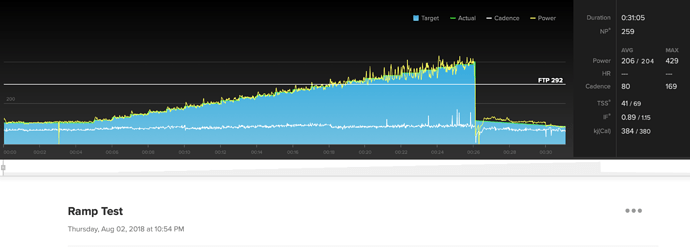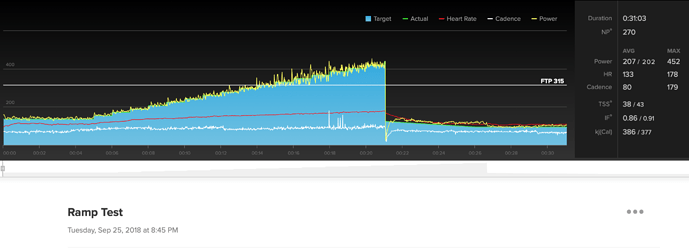My max HR recorded by my garmin was is 185 and that was a couple years ago. I’m 39. During this ramp test it topped out at 178. 2 things. Maybe that is my new max HR. Or maybe the slow fatigue building over the 31min ramp test shut down other systems before I could reach max HR.
![]() same
same
It will be interesting to see your next Ramp Test that is starting at a closer estimate to your actual FTP.
That would be your LT if you had no more drift upwards while holding that power.
As for me, my peak HR from the ramp is the peak HR I get from a really hard VO2 max workout, and equal to my 2nd 8 minute interval in that test.
Well it seems that my experience is fairly typical. As Chad says, it will be interesting to see what happens in my next test with a different starting point closer to my actual FTP. I’m not sure what I will make of it if my HR doesn’t reach HRmax again, and therein lies the problem with trying to read too much into HR data in a scenario such as this. No doubt if my FTP is up I won’t spend too much time worrying about the HR data, and if its not up (or up enough) no doubt I will use the HR data to provide a comforting excuse.
Useful or not I still find it interesting to see how my experience fits with others so thank you all for sharing.
Actually, the age formula is pretty bad for everyone, not just trained athletes. MaxHR is due to genetics and age, and has little to do with fitness.
If you have seen 190 in the last few weeks, then YOUR maxHR is at least 190. (Assuming it is not a measurement error or spike).
Definitely. Last season I estimated my LTHR for running at 176 based on track testing. The age formula would have my MAX at 179, so… no. I’m confident my Max is 190, maybe even a touch higher. I think the 220-Age formula is probably an OK starting point for someone who has little physical exercise background and no clue about anything related to HR.
Max HR’s for the 2 tests where it was recorded are only 2 beats off. I’ve got a ramp test coming up and I haven’t been riding outside too much. A little worried I’ve gotten worse or lost the ability to sustain hard efforts… but this fear is universal on the eve of a ramp test.
Aug 2, 2018 - guess I wasn’t wearing a HR monitor for this, which is out of character
Sep 25, 2018 - max HR 178
Nov 6, 2018 - max HR 181
There’s an mtb climb in the area that is pretty short but very very steep and as I get fitter, I get faster up it and my HR stays a lot lower. Heat plays a major role in how I feel on this climb too. But is it possible that I can push it even harder now given that my HR isn’t maxing out like it used to? As I get stronger am I getting softer?
I think we are likely shifting between failure modes of muscular fatigue vs cardiac fatigue vs mental fatigue. That may well bounce between those as we work through various phases of training. Maybe it ends up being a triangle of sorts and it’s an issue of which one is the weak leg depending on the particular workout or ride?
I get near it but not there on the Ramp test or 8 Min FTP test. My recorded HR for 5s max is 199 during a crit race and 196 for cross. I hit 195 on one Ramp test. For me it never feels like heart or breathing, my legs are just done, I can no longer turn the pedals. Lesson learned, I put too much effort out while racing. ![]()
I’m wondering the same thing now, and can’t find any really definitive answer on this.
The past two ramp tests for me have been unusually low HR at point of failure - but similar FTP range. Max HR I reached was 185 today, 183 in Nov. This is a big change from prior ramp test max HRs for me - in July, 191. May, 189. Apr 192. Feb 191. Jan 192. My max I’ve ever recorded is 193, and pretty sure I saw that in past year on an out of the saddle all out climb effort.
I should add that my HR is usually very stable and predictable over multiple years of riding - ratio to power usually tracks very well with my fitness.
So what changed? In the past few months, I’ve had best ever personal compliance for sustained mid-volume training - starting mostly outdoors in August with very good compliance (live in the country so can follow rigorously) with more indoors recently. All on TR SSB2->1->and now SSB2 again. My overall volume is down since only structured riding remains - the long wandering weeks are gone - so if anything, I’m generally fresher and better rested, so would expect higher HR for that.
I’d like to think lower failure HR in ramp test is just an indicator of increased aerobic capacity, and I do feel that I’m getting much stronger at holding long steady efforts - even started playing around with some TT aerobars this fall for workouts ![]()
But if so - then what work is going to build up the legs to keep up with the newfound strength in the heart? Is this something that will come with more above-threshold work in build phase?
as a rule of thumb the steps on the 1min ramp test are too severe (in terms of intensity) to achieve max HR before neuromuscular power gives out. IF you were able to do the ramp test using cadence alone (or lets says 75% cadence and 25% torque) then there is more chance of achieving maxHR
For simplicity, let’s focus on the fact that within the same ramp test with the same 1 min intervals, there are still very different responses.
For a large number of people it sounds like they do consistently hit max HR - I’d say this included me a few months ago as well.
For others, they report only reaching ~96% - and I’m now finding myself in that bucket.
I think many of us suspect this is telling us something about cardio vs. muscular endurance. But for my case, after the most ever months of highly compliant SSB, which presumably is more muscular endurance and less high end (no VO2 max that would push me into the 180s) - it seems my legs are giving out faster than the heart. It’s the opposite of what I’d expect, so I’m wondering - when are the legs supposed to catch up in these plans?
I was wondering about this very topic recently.
I noted that after taking a break and taking some ‘transition phase’ riding in. When I did my Ramp test I was about 2-3% below my max heart rate. But I could not turn the pedals any more.
I achieved what I consider my max heart rate last may when I was doing a build phase. So I had a few training cycles into me already in the season. I think at this point I had moderate long term fatigue that we would expect when training for a few months.
So, I was wondering if we get a little bit higher heart rate when we have been training for a while and we’re getting positive adaptations?
But, in the end. I don’t find it worthwhile to follow heart rate too closely. If my n=1 experiment has any findings at all. It is that HR varies a bit during different training cycles and you should really just worry about your general range. And this is why power is so much more relevant and useful, when one wants to accurately set interval targets for workouts.
My two most recent most recent ramp tests I hit 185bpm, so about 97.5% of my measured max HR. I’ve never hit 190 again in a ramp test, but I’m much fitter now than that first go. I think I hit 187 in a race last season. So the ramp test may not be a fully true measure of max HR, it gets me awfully darn close.
You should expect to come within a few beats of max HR, assuming you aren’t severely fatigued and don’t bail on the test early.



